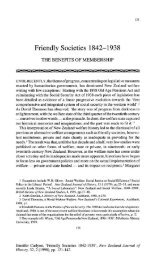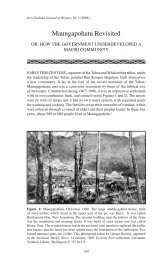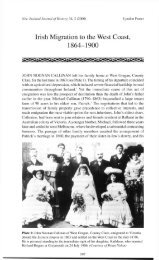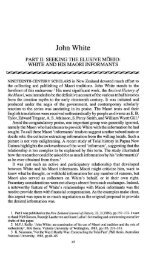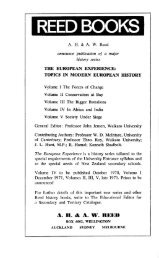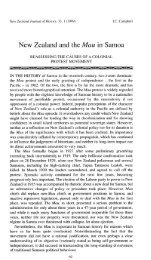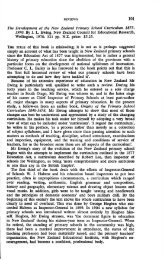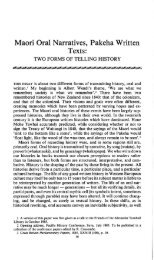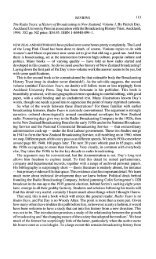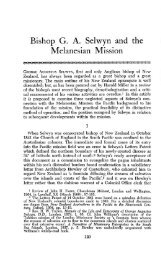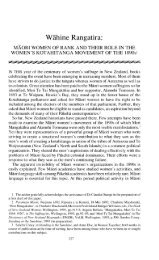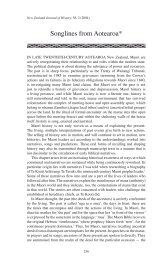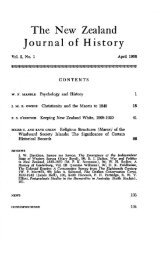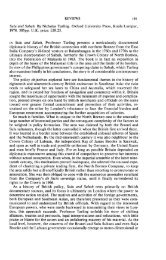John White - New Zealand Journal of History
John White - New Zealand Journal of History
John White - New Zealand Journal of History
You also want an ePaper? Increase the reach of your titles
YUMPU automatically turns print PDFs into web optimized ePapers that Google loves.
JOHN WHITE 167<br />
The draft preface for his book on 'everything that is worth printing' about the<br />
Maori includes the following enigmatic statement, citing Dr <strong>John</strong>son: '"when<br />
truth is sufficient fiction is worse . . ." with the latter remark in our mind we<br />
hope the following pages will be perused'. 68 If this book was truthful, that is<br />
ethnographic, were others he wrote 'fiction', that is literary? A Maori tale, which<br />
was allegedly recorded from an informant, begins:' some books are lies from end<br />
to end, and some great lies were never penned, I think somehow this is (perhaps)<br />
not one'. 69 This revealing line was later erased by <strong>White</strong>. The clearest statement<br />
on the precise relationship between his ethnographic and literary work comes<br />
from Te Aho: 'he tells me that he has a long tale for to tell me, but he will not do<br />
so yet "for" said he "I think you are writing tales, for your own composition,<br />
besides writing all you hear from every person, and after awhile you will tell<br />
people the tales as true" he is a sharp little fellow'. 70 Such suggestive statements<br />
may help to explain why an entirely fictional composition by <strong>White</strong> in the form<br />
<strong>of</strong> an authentic Maori tradition, 'Te Ponga raua ko Te Puhi-huia', came to be<br />
published as authentic in Grey's Nga Mahi a nga Tupuna Maori. 11<br />
This same ethnographical and fictional dualism may also lie behind <strong>White</strong>'s<br />
great historical novel series. Initial sketches <strong>of</strong> his work seem to have been begun<br />
at the behest <strong>of</strong> George Webster. 72 In 1854 <strong>White</strong> started writing the opening<br />
pages <strong>of</strong> the first volume. 73 This was finally published in 1874 as Te Rou. Its<br />
intention is made abundantly clear by the subtitle, 'A Tale, exhibiting the social<br />
life, manners, habits and customs <strong>of</strong> the Maori race in <strong>New</strong> <strong>Zealand</strong> prior to the<br />
introduction <strong>of</strong> civilisation amongst them'. In the preface he wrote that the object<br />
<strong>of</strong> the series was to 'embalm' the fast disappearing Maori knowledge. 74 Characteristically,<br />
a fiction writer again seems to have influenced this work. This time<br />
it was the English historical novelist, Charles Kingsley. 75 Throughout his life<br />
<strong>White</strong> was to give these works the status <strong>of</strong> a popular, but still accurate, history<br />
<strong>of</strong> the Maori. 76<br />
One <strong>of</strong> the more common techniques used by <strong>White</strong> in the Hokianga to collect<br />
such Maori tradition was the continual buttonholing <strong>of</strong> Maori, either during the<br />
course <strong>of</strong> meeting or working with them, or virtually '<strong>of</strong>f-the-street'. He seems<br />
to have been an incessant questioner, ever inquisitive about what or why things<br />
were done. One group <strong>of</strong> Maori helping to grind wheat are reported to have jested<br />
68 JWMS, A143, ATL.<br />
69 'Man and Tui\ 15 February 1847, JWMS, A143, ATL.<br />
70 PJ, 8 December 1847.<br />
71 Simmons, p. 367.<br />
72 PJ, 30 July, 4 August, 25 December 1847.<br />
73 <strong>White</strong> Papers, MS 328, AIM.<br />
74 J. <strong>White</strong>, Te Rou, London, 1874, p. v. Three other book-length novels and some fragments<br />
have been located so far by the author. The second volume is incorporated in the same ms. as Te<br />
Rou, in MS 328, AIM. The other two are in the Wellington Public Library: 'Tale <strong>of</strong> Hari [spelt<br />
Hami]: the Maori Revenge', 'Revenge: a love tale <strong>of</strong> the Mount Eden tribe'. This is a typescript from<br />
which a much-edited version was published by A.W. Reed in 1940 under the same title. The<br />
fragments are located in JWMS, A110, ATL; NZMS 714,1, APL.<br />
75 <strong>White</strong> to Holt, 30 May 1872, JWMS, A77a, ATL.<br />
76 <strong>White</strong> to Moss, c. late May 1885, JWMS, A61, ATL.



